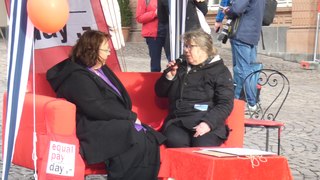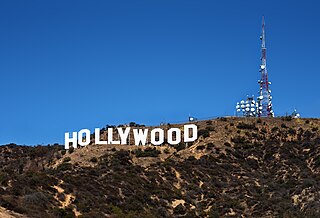
The Screen Actors Guild (SAG) was an American labor union which represented over 100,000 film and television principal and background performers worldwide. On March 30, 2012, the union leadership announced that the SAG membership voted to merge with the American Federation of Television and Radio Artists (AFTRA) to create SAG-AFTRA.
In United States labor law, a hostile work environment exists when one's behavior within a workplace creates an environment that is difficult or uncomfortable for another person to work in, due to illegal discrimination. However, a working environment that is unpleasant and frightening for the victim due to sexual advances that have been denied by the victim, is what constitutes hostile work environment sexual harassment. Common complaints in sexual harassment lawsuits include sexual gossip unrelated to work, jokes about physical contact inappropriate in workplace, commentary on physical appearance/attractiveness, joking about sex acts, fondling, suggestive remarks, sexually-suggestive photos displayed in the workplace, use of sexual language, or off-color jokes. Small matters, annoyances, and isolated incidents are usually not considered to be statutory violations of the discrimination laws. For a violation to impose liability, the conduct must create a work environment that would be intimidating, hostile, or offensive to a reasonable person. An employer can be held liable for failing to prevent these workplace conditions, unless it can prove that it attempted to prevent the harassment and that the employee failed to take advantage of existing harassment counter-measures or tools provided by the employer.

Sexual harassment is a type of harassment involving the use of explicit or implicit sexual overtones, including the unwelcome and inappropriate promises of rewards in exchange for sexual favors. Sexual harassment can be physical and/or a demand or request for sexual favors, making sexually colored remarks, showing pornography, and any other unwelcome physical, verbal, or non-verbal conduct of a sexual nature. Sexual harassment includes a range of actions from verbal transgressions to sexual abuse or assault. Harassment can occur in many different social settings such as the workplace, the home, school, or religious institutions. Harassers or victims can be of any gender.

A glass ceiling is a metaphor usually applied to women, used to represent an invisible barrier that prevents a given demographic from rising beyond a certain level in a hierarchy. The metaphor was first used by feminists in reference to barriers in the careers of high-achieving women. It was coined by Marilyn Loden during a speech in 1978.

The U.S. Equal Employment Opportunity Commission (EEOC) is a federal agency that was established via the Civil Rights Act of 1964 to administer and enforce civil rights laws against workplace discrimination. The EEOC investigates discrimination complaints based on an individual's race, color, national origin, religion, sex, age, disability, genetic information, and retaliation for participating in a discrimination complaint proceeding and/or opposing a discriminatory practice.
Equal pay for equal work is the concept of labour rights that individuals in the same workplace be given equal pay. It is most commonly used in the context of sexual discrimination, in relation to the gender pay gap. Equal pay relates to the full range of payments and benefits, including basic pay, non-salary payments, bonuses and allowances. Some countries have moved faster than others in addressing equal pay.
Employment discrimination law in the United States derives from the common law, and is codified in numerous state, federal, and local laws. These laws prohibit discrimination based on certain characteristics or "protected categories". The United States Constitution also prohibits discrimination by federal and state governments against their public employees. Discrimination in the private sector is not directly constrained by the Constitution, but has become subject to a growing body of federal and state law, including the Title VII of the Civil Rights Act of 1964. Federal law prohibits discrimination in a number of areas, including recruiting, hiring, job evaluations, promotion policies, training, compensation and disciplinary action. State laws often extend protection to additional categories or employers.
Maria Giese is an American feature film director and screenwriter. A member of the Directors Guild of America, and an activist for parity for women directors in Hollywood, she writes and lectures about the under-representation of women filmmakers in the United States.
Gender inequality is the social phenomenon in which people are not treated equally on the basis of gender. This inequality can be caused by gender discrimination or sexism. The treatment may arise from distinctions regarding biology, psychology, or cultural norms prevalent in the society. Some of these distinctions are empirically grounded, while others appear to be social constructs. While current policies around the world cause inequality among individuals, it is women who are most affected. Gender inequality weakens women in many areas such as health, education, and business life. Studies show the different experiences of genders across many domains including education, life expectancy, personality, interests, family life, careers, and political affiliation. Gender inequality is experienced differently across different cultures.

A film director is a person who controls a film's artistic and dramatic aspects and visualizes the screenplay while guiding the film crew and actors in the fulfillment of that vision. The director has a key role in choosing the cast members, production design and all the creative aspects of filmmaking in cooperation with the producer.

LGBT employment discrimination in the United States is illegal under Title VII of the Civil Rights Act of 1964; employment discrimination on the basis of sexual orientation or gender identity is encompassed by the law's prohibition of employment discrimination on the basis of sex. Prior to the landmark cases Bostock v. Clayton County and R.G. & G.R. Harris Funeral Homes Inc. v. Equal Employment Opportunity Commission (2020), employment protections for LGBT people were patchwork; several states and localities explicitly prohibit harassment and bias in employment decisions on the basis of sexual orientation and/or gender identity, although some only cover public employees. Prior to the Bostock decision, the Equal Employment Opportunity Commission (EEOC) interpreted Title VII to cover LGBT employees; the EEOC determined that transgender employees were protected under Title VII in 2012, and extended the protection to encompass sexual orientation in 2015.

The gender pay gap or gender wage gap is the average difference between the remuneration for men and women who are employed. Women are generally found to be paid less than men. There are two distinct numbers regarding the pay gap: non-adjusted versus adjusted pay gap. The latter typically takes into account differences in hours worked, occupations chosen, education and job experience. In other words, the adjusted values represent how much women and men make for the same work, while the non-adjusted values represent how much the average man and woman make in total. In the United States, for example, the non-adjusted average woman's annual salary is 79–83% of the average man's salary, compared to 95–99% for the adjusted average salary.

Advantageous is a 2015 American science fiction drama film starring Jacqueline Kim, James Urbaniak, Freya Adams, Ken Jeong, Jennifer Ehle, and Samantha Kim. The film was released exclusively on Netflix on June 23, 2015.

Inequality in Hollywood refers to the various forms of discrimination and social inequality in the American media industry. There are many branches of the media industry, such as news, television, film, music, agencies, studios, to name some of the major players. In each one of these branches, there are many instances of inequality since Hollywood formed as the entertainment hub of America in the early 1900s.

Women are involved in the film industry in all roles, including as film directors, actresses, cinematographers, film producers, film critics, and other film industry professions, though women have been underrepresented in creative positions.
Women in documentary film describes the role of women as directors, writers, performers, producers, and other film industry professions. According to a 2017 study by San Diego University's Center for the Study of Women in Television and Film, women make up around thirty percent of the population of people working in the documentary film industry, worldwide. In a separate study on the employment of women in indie films, the Center found that overall fewer woman directed independent films were screened at film festivals but that a higher percentage of woman directed documentary films were screened, at 8 films versus 13 documentary films directed by men. In an October 2015 Annenberg study, women documentarians in countries other than the U.S. were 40 percent likely to be “helmers” as opposed to 30 percent likely in the U.S. The study counted films with multiple countries involved “as other countries” but if the U.S. was involved it wasn't counted as “other countries.”
Janal Bechthold is a Canadian composer for film, television, and interactive media most known for creating scores for independent films such as psychological thriller "Art of Obsession", "Martin's Hagge" written by Gordon Pinsent and starring Sheila McCarthy, and video game "The Rival Books of Aster". Recently, Janal composed the music for the new Canadian web-series Begin Again the Series. She is also known as an advocate for women and female-identifying screen composers in Canada.

ReFrame is an American non-profit organization founded by Women in Film LA and the Sundance Institute together with over 50 leaders and influencers in Hollywood, with the goal of providing research, support, and a practical framework to its partner companies to give them a way to "mitigate bias during the creative decision-making and hiring process, celebrate successes, and measure progress toward a more gender-representative industry on all levels". Alison Emilio serves as the director.

Martha M. Lauzen is an American academic and researcher in the field of women in film.
The Original Six are a group of women directors who created the Women's Steering Committee (WSC) of the Directors Guild of America (DGA). Dolores Ferraro, Joelle Dobrow, Lynne Littman, Nell Cox, Susan Bay Nimoy and Victoria Hochberg formed the Women's Steering Committee of the Directors Guild of America in 1979. They carried out landmark research showing that women held only 0.5% of directing jobs in film and television, which they reported to the Guild, the studios and the press.












